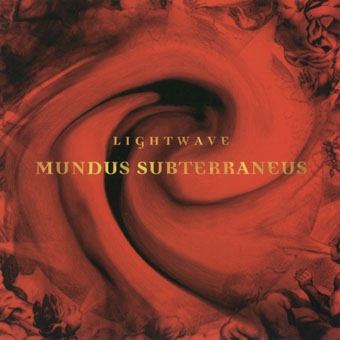Mundus Subterraneus |

|
The following promotional review was written for Hearts Of Space Records.
MUNDUS SUBTERRANEUS, Lightwave (Fathom/Hearts of Space HS11058-2; 65:37), November, 1995.
Returning again to historical prophecy for inspiration, Lightwave follows up Tycho Brahe with Mundus Subterraneus. A subsurface exploration of the truth that lies beyond, and the daemons within.
The work of a 16th century Danish astronomer inspired Lightwave's previous Fathom release. Now a 17th century Jesuit scholar's fascination with the secret knowledge held below our Earth's crust injects new ambient music with throbbing mystery.
ATHANASIUS KIRCHER (1602-1680) was intrigued by the unknown, and devoted his life to the study of scientific and mystical arts. A leading figure in the sciences and spirituality of early-modern baroque Europe, he was inspired by a first-hand observance of Mount Aetna's eruption. At a time when "underground" implied the Underworld, this scholar dared climb the rim of Vesuvius and was lowered into the maw of Hell for a closer examination.
He was fascinated by the archeology of lost knowledge. Years later, Kircher published the profound work MUNDUS SUBTERRANEUS, an 800-page compendium of theories and engravings, encompassing an exploration of geophysics and underworld myth, blending the sensationalism of the past with the science of the future. Working within a tradition of archiving knowledge behind closed doors, his philosophies reflected a faith that the more we learned,... the more remained unknown.

Building upon this dichotomy, Lightwave explores the space under the soil. MUNDUS SUBTERRANEUS is a subconscious tour of a futuristic underworld -- where technological agents and Old World daemons frolic together. This bold new work blends together the grandeur of contemporary ambience with avant garde elements of classical music. The execution is by turns hypnotic, frightening and mischievous, and marks a bold new step in Lightwave's smelting of ambient music with musique concrete and chamber music.
The album opens with a descent into a world of darkness with "De Motu Pendulorum." A mysterious blend of gentle ambience and prescient danger, it leads to occult disturbances residing within the "Cabinet de Curiosites," as the musicians divulge strange and eccentric sounds reminiscent of the expressionist design of Robert Wiene's THE CABINET OF DR. CALIGARI. Digging deeper, the music strikes bedrock in "Sonnenstürme." Here, low, rumbling frequencies provide counterpoint for the violins and synthesizers of contemporary music, as if the Grendels of the past mock and jeer at frail scientific rationale. "Glissement d'Ame" opens upon a strange cave of archaic notions, and Jacques Deregnaucourt's violin solo leads the listener down a recluse's path to a place of arcane scholarship ("Roma Barocca"). Finally, hidden musings yield to brilliant realization, and a transcendent comprehension of a deeper truth comes to light ("Ascension"). We leave the underworld of Kircher as we found it: "Mapping the Earth" promises future trips into the abyss of one man's (and Lightwave's) dark wonder.
Lightwave continues to bridge the gap from early electronic pioneers, such as Richard Pinhas and Klaus Schulze, to modern elements led by Robert Rich, David Sylvian and Future Sound of London. Lightwave takes inspiration from the visionaries of the past to forge uncompromising audio visions of the near future.
Lightwave was formed in 1985 by French electronic musicians CHRISTIAN WITTMAN and CRISTOPHE HARBONNIER. After several tape releases, the duo produced NACHTMUSIK (1990) on the German label Erdenklang. By 1991, the group had been working with French composer and producer Hector Zazou, and Austrian PAUL HASLINGER joined the group. Previously a member of Tangerine Dream, Paul brought a background in classical music and live performance to the experimental nature of Lightwave, and rounded out the group's musical approach.
In 1992, Lightwave again collaborated with Hector Zazou, and David Sylvian, on the SAHARA BLUE album, and contributed to several critically-acclaimed compilations. Lightwave produced TYCHO BRAHE in 1993, initially released by a small French label and subsequently re-released worldwide on the Fathom label to widespread acclaim.
Joining Harbonnier, Haslinger and Wittman on MUNDUS SUBTERRANEUS are guest performers Jacques Deregnaucourt and Charlie Campagna.
-- D.B. Spalding
A self-described multicareerist, D.B. Spalding is a writer, musician, independent radio producer, computer consultant and online sysop; he writes frequently about music, film, computing and the mass- and multimedia.
© Copyright 1995 Fathom division/Hearts of Space, Inc.
© Copyright 1997 D.B. Spalding/